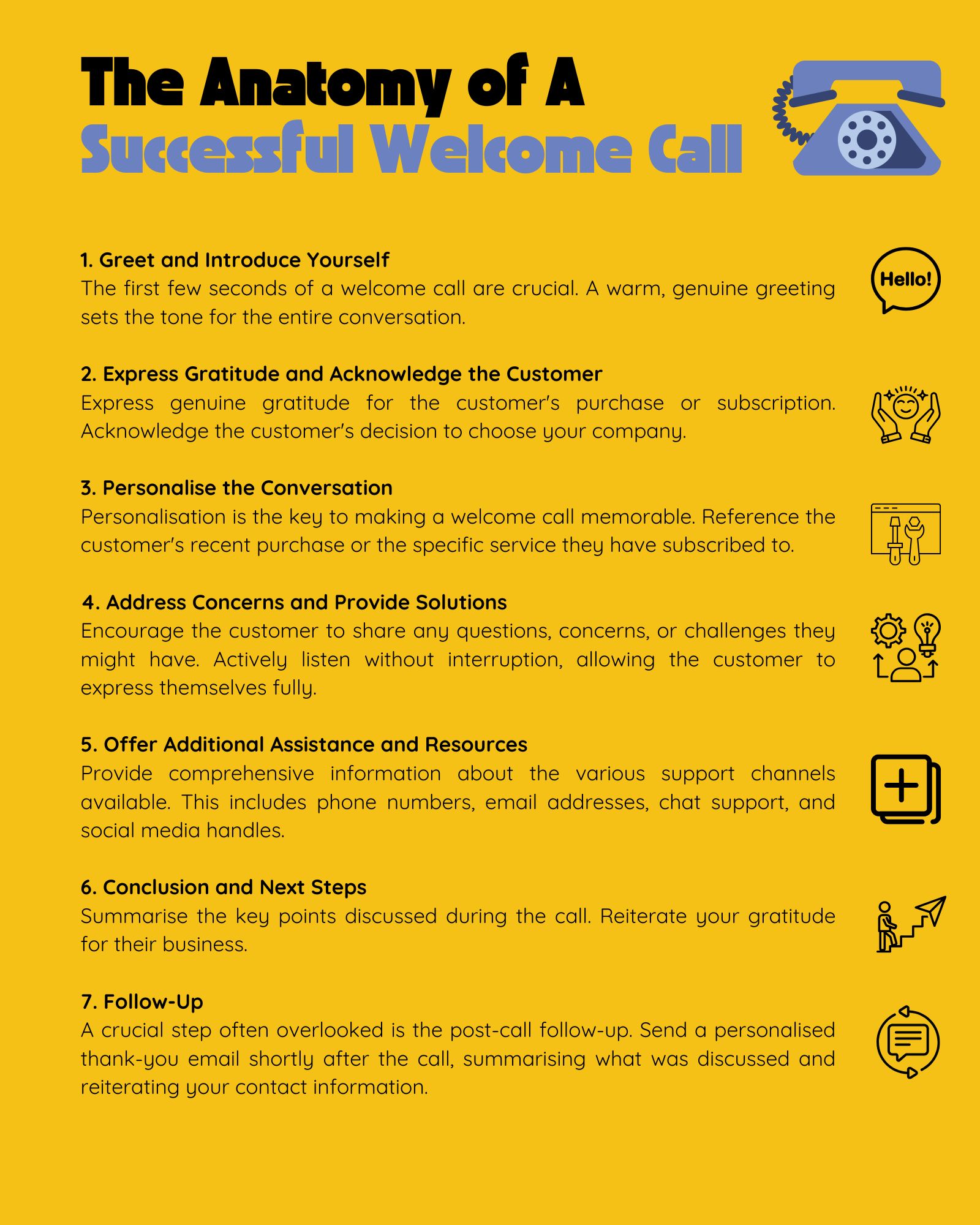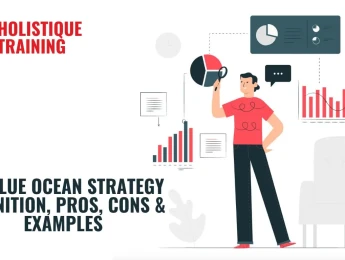- Table of Contents
- Introduction
- What Is a Welcome Call?
- Why Is the Welcome Call Important?
- Building Trust and Loyalty
- Preventing Issues from Escalating
- Enhancing Decision Simplicity
- Encouraging Feedback and Improvement
- Boosting Customer Confidence
- Fostering Emotional Connection
- The Anatomy of a Successful Welcome Call
- 1. Greet and Introduce Yourself
- 2. Express Gratitude and Acknowledge the Customer
- 3. Personalise the Conversation
- 4. Address Concerns and Provide Solutions
- 5. Offer Additional Assistance and Resources
- 6. Conclusion and Next Steps
- 7. Follow-Up
- Challenges and Solutions in Welcome Calls
- 1. Long Wait Times
- 2. Language Barriers and Cultural Differences
- 3. Customer Engagement and Interest
- 4. Data Security and Privacy Concerns
- 5. Maintaining Consistency Across Representatives
- 6. Integration with Other Customer Touchpoints
- Technology and Welcome Calls
- Customer Relationship Management (CRM) Systems
- Artificial Intelligence (AI) and Chatbots
- Data Analytics and Predictive Modelling
- Multichannel Communication Platforms
- Speech Analytics
- Beyond Welcome Calls: Building Lasting Relationships
- 1. Implement Customer Loyalty Programmes
- 2. Personalised Marketing Campaigns
- 3. Regular Follow-ups and Check-ins
- 4. Social Media Engagement and Online Communities
- 5. Proactive Issue Resolution
- 6. Solicit and Act Upon Feedback
- 7. Surprise and Delight
- Conclusion
Introduction
Starting on the right foot is crucial for customer relations. In today's competitive business landscape, where customers have numerous options at their fingertips, making a memorable first impression is essential. One effective strategy for achieving this is through a welcome call. In this article, we will explore the concept of welcome calls, why they are essential, and how to make them successful.
What Is a Welcome Call?
A welcome call is a proactive customer service approach in which a company representative contacts new customers shortly after they have made a purchase or signed up for a service. The call aims to express appreciation, answer any questions or concerns, provide relevant information, and ultimately establish a positive and personal connection with the customer.
Why Is the Welcome Call Important?
Welcome calls are the cornerstone of exceptional customer service, offering many advantages that extend far beyond mere courtesy. Let’s delve deeper into the significance of welcome calls and explore the myriad benefits they offer:
Building Trust and Loyalty
In the ever-evolving business landscape, trust is the currency of customer loyalty. When a representative takes the time to make a welcome call, it demonstrates the company's commitment to customer satisfaction. This personal touch resonates profoundly with customers, making them feel valued and appreciated. In a world where transactions often feel impersonal, a welcome call stands out as a genuine human connection. This emotional bond establishes a strong foundation for lasting customer loyalty, fostering a relationship beyond mere transactions.
Preventing Issues from Escalating
A well-executed welcome call demonstrates a company's commitment to customer satisfaction and fosters a positive relationship right from the outset; if a customer is treated negatively by your business in their first month, they are most likely never to return, according to The Diamond Lab. This is why welcome calls are important in allowing businesses to address any potential issues or concerns early on, preventing them from escalating into larger problems down the line.
Enhancing Decision Simplicity
In addition to the above, an effective welcome call makes the purchasing decision easier for the customer. According to a study by Harvard Business Review, the higher a company scores on the decision simplicity index—a measurement technique used to determine how easy it is for customers to access, navigate, and comprehend information related to a brand–the higher the chance potential customers will purchase from them.
Encouraging Feedback and Improvement
Welcome calls create an open channel for feedback. Customers are more inclined to share their opinions and concerns in a friendly, welcoming conversation. This feedback is invaluable for businesses. Positive feedback reinforces what the company is doing right, boosting employee morale and encouraging the continuation of excellent service practices. On the flip side, negative feedback, when handled well, becomes an opportunity for improvement. By addressing these concerns effectively, businesses can enhance their products, services, or processes, ensuring future customers do not face similar issues. This continuous feedback loop is instrumental in refining the company's offerings and maintaining high customer satisfaction levels.
Boosting Customer Confidence
Welcome calls instil confidence in customers regarding their purchase decisions. When a representative takes the initiative to reach out, it reassures customers that they have made the right choice. The interaction allows customers to seek validation, ensuring they are on the right track. Businesses bolster the customer's confidence in their decision by offering knowledgeable, friendly assistance, reducing buyer’s remorse significantly. Confident customers are likelier to remain loyal to the brand and explore additional products or services, increasing the average customer lifetime value.
Fostering Emotional Connection
Beyond the transactional aspects, welcome calls contribute to the emotional connection between the customer and the brand. Companies tap into customers' emotions by expressing genuine gratitude and care, creating a positive emotional imprint. These emotional connections are powerful. They transform satisfied customers into delighted ones and transform delighted customers into brand evangelists. When customers feel emotionally connected to a brand, their loyalty transcends rational decision-making. They become advocates, defending the brand in conversations and online platforms, contributing significantly to the company’s reputation and growth.
In short, the significance of welcome calls cannot be overstated. They are not just initial interactions but pivotal moments shaping the entire customer journey. By understanding the multifaceted benefits of welcome calls, businesses can harness their potential to foster trust, prevent issues, simplify decisions, encourage feedback, boost confidence, and create emotional connections. Welcome calls are not just a gesture; they are a strategic imperative, a fundamental step toward building enduring customer relationships in the competitive landscape of modern business.
The Anatomy of a Successful Welcome Call
Executing a successful welcome call is an art that involves careful planning, empathy, and effective communication skills. Here are the key elements that constitute a successful welcome call:

1. Greet and Introduce Yourself
The first few seconds of a welcome call are crucial. A warm, genuine greeting sets the tone for the entire conversation. The representative should introduce themselves clearly, mentioning their name and role within the company. A friendly demeanour and a polite tone help establish a comfortable atmosphere, making the customer more receptive to the conversation.
2. Express Gratitude and Acknowledge the Customer
Express genuine gratitude for the customer's purchase or subscription. Acknowledge the customer's decision to choose your company. A simple "Thank you for choosing us" can go a long way in making the customer feel valued. Use positive language that conveys appreciation and excitement about having the customer on board.
3. Personalise the Conversation
Personalisation is the key to making a welcome call memorable. Reference the customer's recent purchase or the specific service they have subscribed to. This demonstrates that you have done your homework and treat them as individuals, not just generic customers. For instance, if a customer bought a specific product, you can say, "I noticed you purchased our XYZ product. It’s a great choice, and I’m here to assist you with any questions you might have about it."
4. Address Concerns and Provide Solutions
Encourage the customer to share any questions, concerns, or challenges they might have. Actively listen without interruption, allowing the customer to express themselves fully. Empathise with their concerns, demonstrating that their feelings and opinions are valued. Once they have shared their concerns, offer practical, empathetic solutions. If the issue requires further assistance, assure them that it will be escalated promptly and resolved to their satisfaction. The aim is not just to resolve problems but also to leave the customer feeling heard and understood.
5. Offer Additional Assistance and Resources
Provide comprehensive information about the various support channels available. This includes phone numbers, email addresses, chat support, and social media handles. Direct them to resources such as FAQs, tutorials, or user manuals. Knowing that help is readily available if they encounter any issues post-call provides customers with a sense of security and support, enhancing their overall experience.
6. Conclusion and Next Steps
Summarise the key points discussed during the call. Reiterate your gratitude for their business. Communicate the next steps, such as expected delivery dates, installation schedules, or any follow-up actions that will be taken. End the call positively, anticipating their satisfaction with the product or service. This final reassurance reinforces their confidence in their decision to choose your company.
7. Follow-Up
A crucial step often overlooked is the post-call follow-up. Send a personalised thank-you email shortly after the call, summarising what was discussed and reiterating your contact information. This email serves as a reference point for the customer and reinforces the positive experience. Follow-up calls or emails a few days after the product or service has been used can further enhance customer satisfaction. Inquire about their experience, address any additional queries, and express continued willingness to assist them. This proactive approach demonstrates an ongoing commitment to their satisfaction.
A successful welcome call is not merely a scripted conversation; it’s a genuine connection forged between the customer and the company. It’s about making the customer feel valued, heard, and supported right from the start of their journey. By incorporating these elements into every welcome call, businesses can create a positive, lasting impression that sets the stage for a strong and enduring customer relationship. Remember, a well-executed welcome call is not just a transactional formality; it’s the foundation upon which meaningful customer relationships are built.
Challenges and Solutions in Welcome Calls
While welcome calls offer tremendous benefits, they are not without challenges. Addressing these challenges effectively ensures a seamless and positive customer experience. Let's explore some common challenges faced during welcome calls and the corresponding solutions:
1. Long Wait Times
Challenge: Customers can become frustrated if they have to wait for an extended period before their welcome call is initiated.
Solution: Implement an efficient call scheduling system to manage call volumes effectively. Utilise technology to predict peak times and allocate resources accordingly. Offering customers the option to schedule their welcome call conveniently can also alleviate this challenge, enhancing the overall customer experience.
2. Language Barriers and Cultural Differences
Challenge: Customers from diverse linguistic and cultural backgrounds may have difficulty understanding the welcome call content, leading to miscommunication and confusion.
Solution: Employ multilingual representatives who can communicate effectively with customers in their preferred language. Provide cultural sensitivity training to representatives, ensuring they know diverse cultural norms and customs. Additionally, offering welcome call scripts in multiple languages and using translation services when necessary can bridge language gaps, ensuring clear communication.
3. Customer Engagement and Interest
Challenge: Some customers might not be receptive to welcome calls, perceiving them as intrusive or unnecessary, leading to disengagement.
Solution: Make welcome calls engaging and interactive. Instead of following a rigid script, empower representatives to personalise their approach based on the customer's responses. Asking open-ended questions, actively listening, and showing genuine interest in the customer's needs can pique their curiosity and engagement. Furthermore, offering incentives or exclusive benefits during the call can enhance customer interest and participation.
4. Data Security and Privacy Concerns
Challenge: Customers may be apprehensive about sharing personal information over the phone due to data security and privacy concerns.
Solution: Prioritise data security by implementing robust encryption protocols and ensuring customer data is stored securely. Communicate the measures taken to protect customer information, assuaging their concerns. Obtain explicit consent from customers before collecting any sensitive data and be transparent about how this information will be used. Building trust regarding data security is crucial for overcoming customer reservations.
5. Maintaining Consistency Across Representatives
Challenge: Inconsistencies in the information provided or the tone of the welcome call across different representatives can lead to confusion and a lack of professionalism.
Solution: Standardise welcome call scripts and provide comprehensive training to representatives to ensure consistency. Regular coaching sessions and performance evaluations can help maintain a uniform standard of service. Implementing call monitoring and feedback systems enables supervisors to identify areas for improvement and provide targeted training to representatives, ensuring a consistent and professional customer experience.
6. Integration with Other Customer Touchpoints
Challenge: The welcome call is just one touchpoint in the customer journey. Ensuring seamless integration with other communication channels and customer interactions can be challenging.
Solution: Implement an integrated customer relationship management (CRM) system that consolidates customer data from various touchpoints. This unified view enables representatives to have context-rich conversations during welcome calls, acknowledging previous interactions and aligning their approach accordingly. Regular communication and information sharing between different organisational departments facilitate a cohesive customer experience across all touchpoints, enhancing overall customer satisfaction.
By proactively addressing these challenges and implementing the corresponding solutions, businesses can transform welcome calls into opportunities for meaningful customer engagement. Overcoming these obstacles ensures a smoother welcome call process and strengthens customer trust, loyalty, and satisfaction. As businesses navigate the intricacies of welcome calls, the ability to effectively handle challenges becomes a testament to their commitment to exceptional customer service, ultimately contributing to long-term customer relationships and organisational success.
Technology and Welcome Calls
Technological evolution has revolutionised how businesses operate, and welcome calls are no exception. Leveraging advanced technologies enhances the efficiency, personalisation, and overall impact of welcome calls, making them even more significant in the realm of customer relations.
Customer Relationship Management (CRM) Systems
CRM systems are invaluable tools for managing customer interactions and data. These platforms allow businesses to store and organise customer information efficiently. During a welcome call, representatives can access the customer's purchase history, preferences, and any previous interactions. Armed with this data, representatives can personalise the conversation effectively, referencing specific products or services the customer has shown interest in previously. This level of personalisation impresses the customer and strengthens the company's understanding of individual customer needs, facilitating future interactions and engagements.
Artificial Intelligence (AI) and Chatbots
AI-driven technologies, including chatbots, analyse customer data in real-time, enabling dynamic, personalised interactions. Chatbots can engage customers in automated yet highly personalised conversations based on their preferences and purchase history. In the context of welcome calls, AI algorithms can predict customer behaviour patterns, allowing representatives to anticipate customer needs and concerns accurately. For instance, if a customer has bought a smartphone, the system can predict potential queries about accessories or provide information about related products, enabling the representative to proactively address these topics during the call. AI streamlines the welcome call process and ensures a level of personalisation that was once challenging to achieve at scale. This, in turn, is making everyone’s lives easier. In fact, approximately 60% of customer service professionals report that AI technology has resulted in significant time savings for them, according to LinkedIn.
Data Analytics and Predictive Modelling
Data analytics tools enable businesses to gain actionable insights from customer data. By analysing past welcome call interactions, companies can identify trends and patterns. Predictive modelling algorithms can forecast customer behaviour, allowing businesses to tailor their welcome calls based on these predictions. For example, if data suggests that customers from a specific region often inquire about delivery timelines, representatives can proactively address this topic during welcome calls with customers from that region. Predictive modelling enhances the proactive nature of welcome calls, ensuring customer concerns are addressed before they voice them, thereby significantly augmenting customer satisfaction.
Metric | Description | Importance |
Net promoter Score | Measures customer loyalty and advocacy | Indicates brand strength, predicts growth |
Customer Effort Score | Gauges ease of customer interactions | Lower effort correlates with higher loyalty. |
Customer Satisfaction (CSAT) Score | Rates overall customer satisfaction. | Immediate feedback, measures transactional experiences. |
Churn Rate | Measure the percentage of lost customers. | Reflects dissatisfaction or competitive pressures |
Retention Rate | Measures the percentage oof retained customers. | Indicates brand loyalty and customer value |
Table 1: Customer satisfaction metrics comparison
Multichannel Communication Platforms
Modern businesses operate across various communication channels, including phone calls, emails, social media, and messaging apps. Multichannel communication platforms integrate these channels, allowing representatives to engage with customers seamlessly. During a welcome call, if a customer prefers email communication, their preferences can be noted in the CRM system. Subsequent interactions, including follow-up emails or promotional offers, can be tailored to match their preferred channel. This adaptability ensures that the customer receives information and updates in the manner they find most convenient, enhancing their overall experience and satisfaction.
Communication Channel | Advantages | Challenges |
Phone Calls | Personalised, direct, immediate interaction. | Long wait times, potential miscommunication. |
Allows detailed communication, easy documentation. | Risk of being ignored, may lack immediacy. | |
Social Media | Broad reach, interactive, fosters community. | Public negative feedback requires active monitoring. |
Live Chat | Real-time support, convenient for customers. | Limited complexity of issues addressed. |
In-person Support | High personalisation, immediate issue resolution. | Limited by geographical presence, resource-intensive. |
Table 2: Customer engagement channels comparison
Speech Analytics
Speech analytics technology analyses the spoken words during customer interactions, identifying keywords and phrases. In the context of welcome calls, speech analytics can detect customer sentiment, helping representatives gauge the customer's mood. If a customer expresses frustration or dissatisfaction, the system can alert the representative, enabling them to address the issue promptly and effectively. Speech analytics also assist in training representatives by providing insights into common customer queries and concerns, allowing companies to refine their welcome call scripts and approaches continuously.
Incorporating these advanced technologies into the welcome call process elevates customer interactions to a new level. By embracing CRM systems, AI-driven solutions, data analytics, multichannel communication platforms, and speech analytics, businesses can enhance the efficiency of their welcome calls and deliver highly personalised, proactive, and empathetic customer experiences. When harnessed effectively, technology transforms welcome calls from routine interactions into strategic engagements, strengthening customer relationships and contributing significantly to long-term customer satisfaction and loyalty. Backed by cutting-edge technology, welcome calls become powerful tools that shape positive customer perceptions and fuel business success in the digital age.
Beyond Welcome Calls: Building Lasting Relationships
Welcome calls mark the beginning of the customer journey, but building lasting relationships requires ongoing effort and engagement. Here are key strategies and practices that extend beyond welcome calls to foster enduring connections with customers:
1. Implement Customer Loyalty Programmes
Loyalty programmes are excellent incentives for customers to stick with a brand. By offering rewards, discounts, or exclusive access to certain products or services, businesses can encourage repeat purchases and create a sense of exclusivity. These programmes increase customer retention and enhance customer satisfaction as clients feel appreciated for their loyalty.
2. Personalised Marketing Campaigns
Personalisation is paramount in today's customer-centric landscape. Utilise customer data collected during welcome calls and other interactions to tailor marketing campaigns. Personalised content, such as product recommendations based on past purchases or personalised email offers, demonstrates that the company understands and values each customer's unique preferences, strengthening the emotional connection.
3. Regular Follow-ups and Check-ins
Regular follow-ups post-purchase demonstrate ongoing care. Follow-up calls, emails, or messages expressing gratitude for their continued loyalty and inquiring about their satisfaction reinforce the customer's importance to the business. Additionally, these check-ins allow customers to voice concerns, ensuring prompt resolution and showing that their opinions matter.
4. Social Media Engagement and Online Communities
Active engagement on social media platforms and online communities fosters a sense of community among customers. Businesses create an environment where customers feel heard and valued by participating in discussions, responding to comments, and sharing user-generated content. Moreover, these platforms provide opportunities for customers to interact with the brand and other customers, strengthening their emotional attachment and sense of belonging.
5. Proactive Issue Resolution
Address customer issues proactively and efficiently. Implement a robust customer support system that allows customers to reach out easily when problems arise. The key is not just resolving the issue but doing so promptly and empathetically. When customers see that their concerns are taken seriously and resolved to their satisfaction, it enhances their trust in the brand and solidifies their relationship.
6. Solicit and Act Upon Feedback
Encourage customers to provide feedback about their experiences. This feedback, whether positive or negative, is invaluable. Act upon it by making necessary product, service, or process improvements. Communicate these changes back to customers, demonstrating that their opinions directly impact the business. This proactive approach strengthens customer relationships and contributes to continuous improvement.
7. Surprise and Delight
Occasionally, surprise customers with unexpected gestures of appreciation. It could be a personalised thank-you note with a customer's purchase, a small gift, or an exclusive offer. These surprises create memorable experiences, making customers feel valued and special. Such gestures go a long way in fostering emotional connections and positive word-of-mouth referrals.
Building lasting relationships goes beyond transactions; it involves consistent, genuine efforts to create positive experiences and emotional connections. By implementing these strategies, businesses can transform one-time buyers into loyal advocates who continue to support the brand and enthusiastically recommend it to others. Ultimately, these efforts contribute to a strong brand reputation, sustained customer satisfaction, and enduring success in the market.
Conclusion
In an era of ever-increasing competition, companies need to go the extra mile to stand out from the crowd. Welcome calls present an excellent opportunity to establish a positive and personal connection with customers from the very beginning. By expressing gratitude, addressing concerns, and providing valuable information, companies can build trust and loyalty that will contribute to long-term success. Embrace the power of the welcome call and unlock the potential for stronger customer relationships and increased customer satisfaction. If you need help to manoeuvre a welcome call and create a successful customer engagement strategy, then our ‘Creating a Customer Engagement Strategy’ course has got you covered. Get in touch now for more information.






















